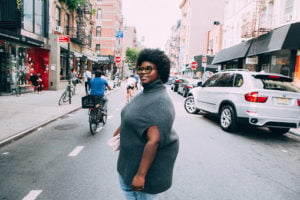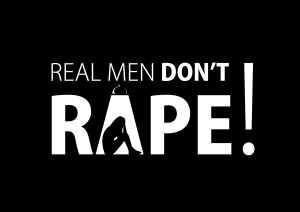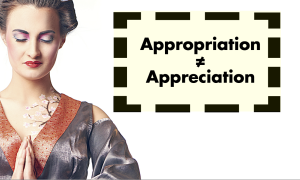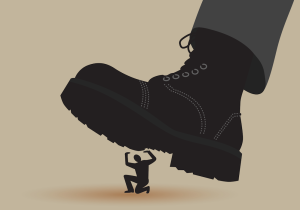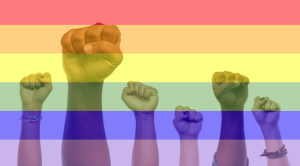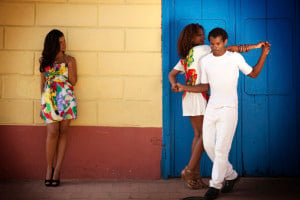I’m sitting on a body-positive panel in New York City, surrounded by myriad bloggers, activists, artists, and allies.
Five women and femmes are pouring out their hearts on stage, right beside me. They discuss struggles with eating disorders, toxic upbringings, lifetimes of bullying, life-stopping self-doubt bred by diet culture and mainstream media alike, and body dysphoria.
They’re all powerhouses, radical in their willingness to fight for and maintain self-love.
The panel is followed by a “feminist” and “body-positive” comedy show. When the first comedian goes up, she tells a joke about not fitting into her straight size pants after eating “too many cupcakes” and growing “too fat.”
The next one talks about being the “fat, ugly sister” in the family. She is quite thin. When a third arises, she laughs about once being ridiculed for her “fat ass.” She, too, is slender.
And so on and so forth, every petite comedian at the “body-positive” panel shares an uncomfortable and entirely inappropriate fat joke.
In a conversation with one of the ladies post-show (after she happened to realize that most of the crowd was angry as fuck), it became very clear that she didn’t understand why her words or those of her colleagues were problematic.
To her, the ingrained belief that fatness and fat people exist for comedic purposes was preserved alongside the belief that she was, in fact, “body-positive.”
This isn’t an uncommon occurrence.
The more mainstream the term “body positivity” has become, the more humans have been reducing it to a vague slogan: “All bodies are good bodies.” Often, these same people aren’t actively working on ensuring (or fighting for) the equal treatment of all those bodies. Or, worse still, they’re not making any effort whatsoever to hide their disdain for many of them.
Body positivity was arguably born of the radical fat acceptance movement and its alignment with representing queer bodies, bodies of color, and disabled bodies. When I started blogging in 2012, “BoPo” was used principally by activists wanting to combat the toxic effects of diet culture and all those media-fueled ideals of homogenized beauty.
It was used by those who understood that people’s fatness is, to this day, considered fodder for denying them healthcare, paying them less money, convicting them of a crime, as well as generally humiliating them.
As tends to happen when any kind of radical principal goes mainstream (see “feminism,” often known as bubblegum “girl power” and little else), the inevitability of its dilution feels sadly real.
Below are some pretty clear signs that one’s body positivity could afford to be more open-minded.
The good news is that we can all strive for self-improvement. The first step is just isolating the problem(s).
1. You Think Fat People Are ‘Okay’ as Long as They’re ‘Healthy’
If this sounds like you, then chances are you have turned “health” into a beauty standard in and of itself.
This, however, is an incredibly ableist way of thinking. Expecting everyone to maintain “perfect” health assumes that we all have the exact same physical and mental abilities needed in order to do so. It doesn’t account for illness or injury. Nor does it account for the simple fact that health may very well look different from individual to individual.
But it also implies that “health” is a prerequisite for acceptance, particularly when it comes to fat folks.
At the end of the day, however, people are people. And whether someone is fit or unfit, healthy or unhealthy, they deserve to be treated as such.
Truthfully, most of us participate in healthy and unhealthy activities. Maybe we smoke. Maybe we have unprotected sex with one-night-stands. Maybe we rock climb without the proper equipment. Maybe we speed on the highway. Maybe we spend a week or a month eating takeout. Maybe we regularly drink until we hurl.
Ultimately, those decisions are ours to make. No one gets to assume ownership over anyone else’s life.
2. You Think Fat Bodies Are Beautiful, But Only Under Certain Conditions
Mainstream body positivity is largely about fair-skinned smaller fats: plus size individuals with “curves in the right places,” if you will. Many of whom are also white or white-passing.
These folks undoubtedly have a place in plus size fashion and in body positivity. However, centering the conversation on them does nothing for the visibility and representation of actual fat people.
Those are the ones who are probably being denied healthcare because of their BMI, or who still don’t have the clothing options. or who have to pay twice as much money to fly anywhere, or who are constantly made to feel like the unsightly “before” image in before and after advertisements.
Nor does it do anything to challenge the fact that the intersection of fatness and race creates a whole heap of other problems.
If you claim to be body positive, it’s time to realize that fat bodies don’t stop at a size 18.
They come in all shapes and incarnations, many of which are not hourglass-like. They’re not all white. But they’re all damn fine.
3. Transgender Women Don’t Have a Place in Your Definition of ‘Womanhood’
Although trans rights (and the hideous lack thereof) became a hot topic in 2016, many body-positive advocates still don’t seem to carve out a ton of space for transgender women.
Be it by aligning feminism and womanhood with vagina-centric rhetoric, denying the simple fact that not all women have vaginas in the first place, or failing to recognize how existing as a trans person often leads to more marginalization, far too many of us are still doing a disservice to our trans sisters.
Plain and simple, your inclusivity is not actually all that inclusive if it forgets transgender women or keeps them on the sidelines.
It’s time to listen to the struggles of trans women – when it comes to body image and a whole lot more.
4. You Don’t Think Disabled Bodies Are Underrepresented
Have you considered the lack of representation for disabled people?
Does it trouble you that there are no wheelchair-, cane-, or hearing-aid-using babes in that “body pos” retail advertisement? Does thinking about the lack of widely known fat, disabled models or disabled models of color make your skin crawl?
Unfortunately, mainstream BoPo still has a long way to go in championing disabled rights.
But it’s high time that disabled children open up a magazine or newspaper and see someone like them staring back.
5. To You, Curvy People Are Cool, But Fat Activists Are Dangerous
I regularly receive e-mails in which I’m attacked for “promoting” or “glorifying” obesity.
Oftentimes, they come from people who believe my prime goal is to turn everyone fat: to strip passerby of their thigh gaps and infect the children with Stage 4 VBO.
Never mind the fact that the size of one’s body reveals nothing about one’s health.
Never mind the fact that aesthetic homogenization is simply not my jam, in either weight-related direction. Never mind that I actually do “glorify” obesity, if the definition of “glorification” you’re using is “to make glorious.”
This, I believe, is important when we consider just how little glory or respect are generally bestowed upon fat bodies.
In actuality, fat activists have been entirely positive, progressive forces in the lives of thousands of people out there – people who’ve long been told that self-love and self-worth and self-care are not for them on the grounds of size alone.
6. You Say All Women and Femmes Are Subject to the Same Levels of Intolerance
I will preface this by saying that all women and femmes are undoubtedly subject to misogyny and sexism. And a lot of that misogyny and sexism manifest in the pressure to look a very particular way, which then fucks with people’s body image.
That said, there is also no denying that if you were to define feminine beauty as per Western society’s core definition of it, it would probably look very white, very thin, very able, very heteronormative, and very Eurocentric in its symmetrical features.
This means that any deviation from that package will likely lead to some kind of intolerance or marginalization. And the more deviations you add, the more intolerance or marginalization are likely.
For this reason, a thin white woman is less likely to be belittled for her body than a fat white woman. An hourglass-shaped fat woman is less likely to be hated on than a boxy-shaped one. But a fat, boxy woman of color is the most likely to be chastised of the bunch.
7. You Still Preach the Idea That Only Certain Bodies Should Wear Certain Clothes
The concept of “flattering” still runs deep within many supposed advocates of body positivity. It is essentially the notion that only certain body types are worthy of certain clothes. It’s also regularly used as a synonym for “slimming.”
Here’s the thing: Fashion “rules” are a whole heap of BS. People deserve to wear the clothes that make them happy regardless of whether that color “clashes” with their complexion. Regardless of how “big” you think their ass looks in that dress. Regardless of how much attention their fat body might attract on the street. Regardless of whatever it is you think about their outfit at all.
8. Weight Loss and Plastic Surgery Advertisements Align with Your Body Positivity
It’s definitely not up to me to tell anyone else what they’re allowed to find empowering on a personal level.
If you truly believe that weight loss or plastic surgery will positively affect your life in a meaningful way (and not just because someone else made you feel that they would), then right on. It’s your choice to participate in these practices, much like it’s my choice not to.
However, please don’t co-opt a term born of activism for such practices.
These practices are arguably rooted in making women and femmes feel like they’re too old, too fat, too wrinkled, too flat-chested, too stretch mark-adorned – and never enough.
What’s empowering to you may – at its core – not be empowering to all. It may not be “radical,” either. Try to be mindful of this.
9. You Spend a Lot of Time Thinking or Talking About Other People’s Bodies
I’m willing to bet that there are plenty more interesting things about you than your body or your diet.
I’m also willing to bet that you have a lot more to say than how so and so looks in that ensemble. People’s bodies don’t exist for public consumption and digestion. They just don’t.
Unfortunately, women and femmes are all too often encouraged to bond over body talk: to pick apart their figures, their friends’ figures, celebrity figures, and even the dogs’ figures in an effort to relate to one another.
But maybe you like politics. Perhaps you just read an incredibly memorable novel. Did you recently come across a painting you really loved? Or how about an article on that feminist website? What did you and your partner(s) get up to over the weekend? What totally ridiculous telenovela did you spend last night watching? How is that work project going?
Consider talking about these things instead. Experience tells me you’ll have a far more interesting lunch date, or get-together, or life if you do so.
***
And maybe that’s what it all comes down to.
So often, we’re reduced to our bodies. We’re told that we’re not enough, or too much. It’s said that our shapes correlate to our moral compasses. So we’re urged to change them, in order to be more accepted by those around us.
Body positivity, however, was originally meant to serve as a rebel force in that narrative. These days, far too much of it is unfortunately feeding the narrative instead.
This will not change unless we exercise mindfulness in our own actions and words, though.
We must stray from the cookie cutter definition of the term and take it back to its radical roots – where it arguably always belonged.
[do_widget id=’text-101′]
Marie (otherwise known as Miggle) Southard Ospina is a Contributing Writer for Everyday Feminism. She is a freelance journalist and size acceptance activist. Her loves include: writing about plus size fashion, body politics, and fat positivism; watching a lot of sci-fi; and listening to ungodly amounts of folk music. She can be found discussing body image on Good Morning America and StyleLikeU, with writing on Bustle, Refinery29, BuzzFeed, Huffington Post, and Volup2. Read her articles here.
Search our 3000+ articles!
Read our articles about:
Our online racial justice training
Used by hundreds of universities, non-profits, and businesses.
Click to learn more
Most Read Articles
- « Previous
- 1
- …
- 30
- 31
- 32


